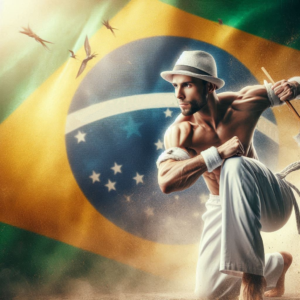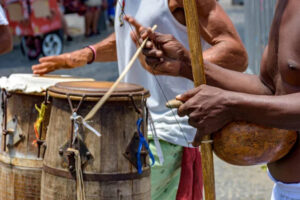Timeline of Capoeira history

The explorer Pedro Álvares Cabral (1467-1520) claimed the lands of Brazil for the Portuguese crown, initiating the transportation of enslaved people to the new colony.
The first known shipment of enslaved people arrives in Brazil, marking the beginning of the transatlantic slave trade in the country.

Between 1583 and 1598, the word "capoeira" first appeared in Portuguese in the work "Tratados Da Terra E Gente Do Brasil" by Father Fernão Cardim. In this context, "capoeira" referred to secondary vegetation or an abandoned farm.
On average, 5,600 enslaved people were forcibly transported to Brazil each year, fostering the spread of capoeira among the African enslaved population.

Founded by runaway slaves, Quilombo dos Palmares emerged in the current state of Alagoas. The secrecy required makes it difficult to pinpoint the exact date of its establishment.
Pictured: Serra da Barriga, in União dos Palmares, Alagoas, is the Palmares Memorial Park. The houses of Brazil's largest quilombo have been reconstructed based on historical documents.
The Dutch invasion of the Northeast destabilized sugar production and facilitated the escape of enslaved people, with the first documented mentions of capoeira dating back to this period.
The Dutch invasions begin, including attacks on Quilombo dos Palmares. The social unrest on the Brazilian coast drives enslaved Africans to flee inland.
The Dutch attempt to subjugate Quilombo dos Palmares is repelled by its inhabitants.
The Portuguese expelled the Dutch from northeastern Brazil, forcing them to retreat from the country.

Zumbi, the grandson of the Congolese princess Aqualtune, is born in Quilombo dos Palmares. Raised in a community of escaped slaves, Zumbi becomes a symbol of resistance and freedom for Afro-Brazilians.
As a child, Zumbi is kidnapped by Portuguese soldiers, taken to Porto Calvo, and given to the Jesuit António Melo, where he is baptized and named Francisco.

At the age of 15, Zumbi escapes and returns to Palmares. In the same year, Ganga Zumba (pictured), son of Princess Aqualtune, assumes leadership of the quilombo, which has grown to over 30,000 inhabitants.
Zumbi proves to be a great warrior and military organizer in the fight against Portuguese soldiers commanded by Manuel Lopes. After a five-month retreat, the quilombo inhabitants counterattack, forcing Manuel Lopes to retreat to Recife.
Zumbi succeeds Ganga Zumba and leads the resistance against Portuguese troops in Palmares.

Domingos Jorge Velho (c. 1641–1705) and Vieira de Melo lead the final attack on Cerca do Macaco, the main village of the quilombo of Palmares. Although wounded, Zumbi manages to escape.
In the image: Domingos Jorge Velho in the work of Benedicto Calixto.
After many attempts, Quilombo dos Palmares is invaded and conquered. Zumbi, betrayed by an old friend, is captured and beheaded at the age of 40. He is remembered as a hero and martyr by abolitionists, and his death marks the end of organized resistance in Palmares, but his spirit continues to inspire generations.
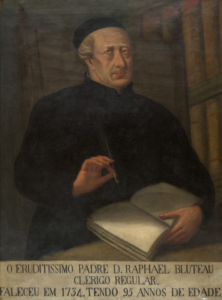
The word "capoeira" appears for the first time in the "Diccionario da lingua portugueza" compiled by Father D. Raphael Bluteau (1638-1734), although the meaning does not refer to the fight.
In 1770, capoeira is first documented as a form of combat, describing the techniques used by enslaved Africans in Brazil. Combining fighting, dance, music, and acrobatics, capoeira developed as a means of resistance against colonial oppression.
The term "capoeira" first appears in police records with the arrest of a young man named Adão, who was sentenced to 500 lashes for involvement in a fight between capoeiristas.
D. Joao VI established the Royal Police Guard, appointing Major Miguel Nunes Vidigal as its commander. Vidigal, known for his persecution of capoeiristas, was himself a skilled capoeira practitioner.
The Rio de Janeiro Military Commission requests the Ministry of War to publicly punish Black capoeira practitioners.
Prince Regent Dom Pedro I proclaims Brazil's independence from Portugal with the "Cry of Ipiranga," marking the end of colonial rule and the beginning of the Brazilian Empire.
The Brazilian government bans dances, often used to mask combat practices like capoeira, as part of a broader effort to suppress slave activities and maintain public order.

The Emperor of Brazil, Dom Pedro II, promulgates the "Lei do Ventre Livre" (Law of Free Birth), decreeing that children born to enslaved women would be considered free, marking a significant step towards the abolition of slavery in Brazil.
Image: The first page of the "Lei do Ventre Livre" (Law of the Free Birth).
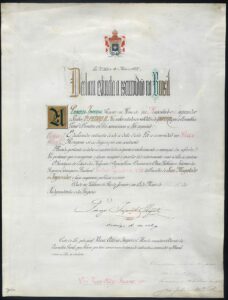
Abolition of Slavery in Brazil. Princess Isabel signs the "Lei Áurea" (original letter pictured), abolishing slavery in Brazil, likely under pressure from José Carlos do Patrocínio.
Brazil's white elites adopted a 'whitening' policy, encouraging European immigration to alter the country's ethnic composition. Raimundo Nina Rodrigues contributed to this ideology through his studies and racial theories.

Vicente Ferreira Pastinha, known as Mestre Pastinha, is born in Salvador de Bahia. He is the founder of the first capoeira Angola school and is renowned for preserving the tradition of capoeira Angola.
A military coup led by Marshal Deodoro da Fonseca marked the end of the Brazilian Empire and the beginning of the First Republic, significantly impacting cultural practices, including the spread of martial arts.

President Marshal Deodoro da Fonseca (1827-1892) formally banned African cultural expression, including capoeira, in Brazil.

Finance Minister Ruy Barbosa de Oliveira (1849-1923) signed a resolution to erase the period of slavery from Brazil's history, resulting in the burning of many public documents related to African slaves.

Manoel dos Reis Machado, known as Mestre Bimba, is born in Salvador de Bahia. He is considered the father of Regional capoeira. Bimba developed Regional capoeira, introducing new techniques and a structured teaching method.
Mestre Bimba reformed capoeira, incorporating elements of jiu-jitsu, gymnastics, and sports, making it more socially acceptable.
Mestre Bimba opens his Academia de Luta Regional Bahiana, later simply called capoeira Regional, in Salvador de Bahia.

President/dictator Getulio Vargas (1882-1954) legalizes various Afro-Brazilian cultural expressions, including capoeira.
Vicente Ferreira Pastinha, known as Mestre Pastinha, founded his first Capoeira Angola academy in Salvador, Bahia, preserving and spreading this traditional form of capoeira.
Mestre Bimba's academy receives official recognition from the Secretariat of Education, Health, and Public Services, becoming the first legitimate capoeira academy in Brazil and contributing to the spread and legitimization of Regional Capoeira.

Mestre Pastinha founded the CECA (Centro Esportivo de Capoeira Angola) in Salvador de Bahia, a landmark for Capoeira Angola.

Floriano Franklin Canela, known as Mestre Canela, was born in Rio de Janeiro. He started practicing capoeira as a child and founded the Mangangà group.
Capoeira is introduced as an effective combat practice at the Guanabara Police Academy in Rio de Janeiro.
Pioneers like Mestre Acordeon brought capoeira to the United States and Europe, contributing to its international recognition.
Mestre Bimba, one of the most important capoeira masters and developer of the Regional Capoeira style, passed away.
Capoeira is recognized as the national sport of Brazil, marking a significant milestone for the discipline.
Old, sick and nearly blind, Mestre Pastinha suffered a cerebral edema and was forced to leave his school premises, which were never returned to him.
At the end of 1979, Mestre Canela departed for Europe along with Mestre Zè-Maria and other Brazilian artists.
Mestre Pastinha dies abandoned in a municipal hospice in Salvador, Bahia.
Mestre Canela settled in Viterbo and founded the Capoeira Mangangà group, starting the dissemination of capoeira in Italy.
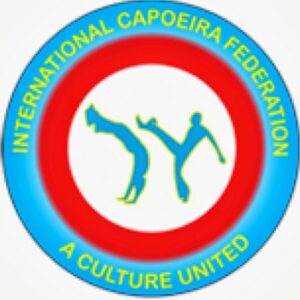
The International Capoeira Art and Culture Foundation (ICAPF) is founded to promote capoeira worldwide.
The Confederação Brasileira de Capoeira (CBC) is founded with the goal of preserving and spreading the culture and values of capoeira in Brazil. The first president of the CBC is José Tadeu Carneiro Cardoso, known as Mestre Gato.e Gato.

Brazil commemorates the 300th anniversary of King Zumbi's death with a large march against racism in Brasilia, attended by 30,000 Afro-Brazilians.

Thanks to the tireless mobilization of the Brazilian Black Movement, Zumbi, the last leader of Quilombo dos Palmares, is recognized as a National Hero by the Federal Government.
The Federazione Italiana Capoeira (FICAP) is founded with the aim of promoting capoeira in Italy.
The Federazione Italiana Capoeira (FICAP) is officially recognized by the Federazione Italiana Judo Lotta Karate ed Arti Marziali (FIJLKAM) to ensure the continuity of all initiatives, teaching, training, and organizations related to this discipline at a national level.

The World Capoeira Federation (WCF) is founded in October 2011 to promote capoeira worldwide.
UNESCO inscribes the Capoeira roda on the Representative List of the Intangible Cultural Heritage of Humanity, recognizing capoeira as a celebration born from resistance against all forms of oppression. The roda provides a sense of community and identity to a growing community, promoting dialogue between different ethnicities, social classes, and nationalities.
In Viterbo, Italy, Mestre Canela passes away. He was the founder of the first Italian capoeira school and a leading figure in promoting this martial art in Europe.


